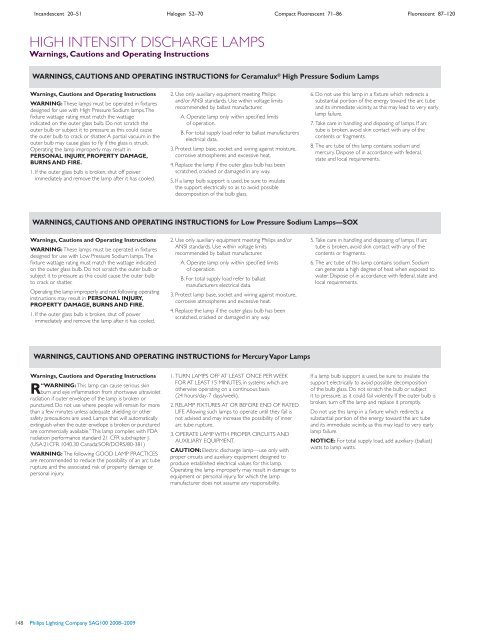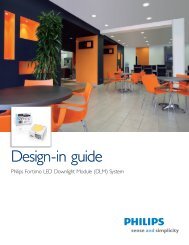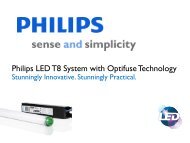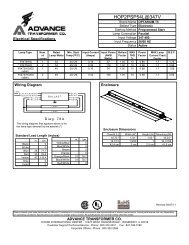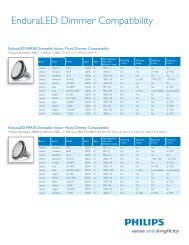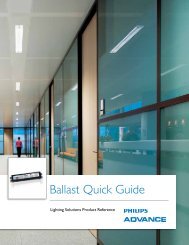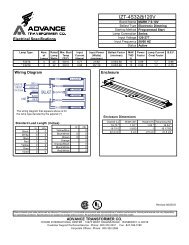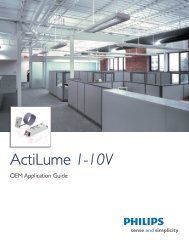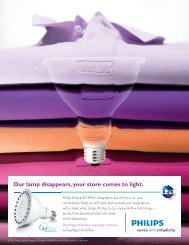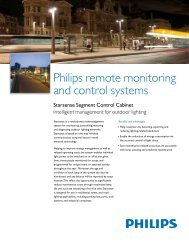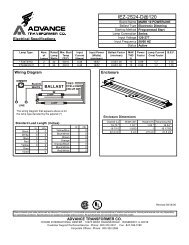Lamp Specification and Application Guide 2008 ... - Philips Lighting
Lamp Specification and Application Guide 2008 ... - Philips Lighting
Lamp Specification and Application Guide 2008 ... - Philips Lighting
Create successful ePaper yourself
Turn your PDF publications into a flip-book with our unique Google optimized e-Paper software.
Inc<strong>and</strong>escent 20–51 Halogen 52–70<br />
Compact Fluorescent 71–86 Fluorescent 87–120<br />
HIGH INTENSITY DISCHARGE LAMPS<br />
Warnings, Cautions <strong>and</strong> Operating Instructions<br />
WARNINGS, CAUTIONS AND OPERATING INSTRUCTIONS for Ceramalux ® High Pressure Sodium <strong>Lamp</strong>s<br />
Warnings, Cautions <strong>and</strong> Operating Instructions<br />
WARNING: These lamps must be operated in fixtures<br />
designed for use with High Pressure Sodium lamps. The<br />
fixture wattage rating must match the wattage<br />
indicated on the outer glass bulb. Do not scratch the<br />
outer bulb or subject it to pressure as this could cause<br />
the outer bulb to crack or shatter. A partial vacuum in the<br />
outer bulb may cause glass to fly if the glass is struck.<br />
Operating the lamp improperly may result in<br />
PERSONAL INJURY, PROPERTY DAMAGE,<br />
BURNS AND FIRE.<br />
1. If the outer glass bulb is broken, shut off power<br />
immediately <strong>and</strong> remove the lamp after it has cooled.<br />
2. Use only auxiliary equipment meeting <strong>Philips</strong><br />
<strong>and</strong>/or ANSI st<strong>and</strong>ards. Use within voltage limits<br />
recommended by ballast manufacturer.<br />
A. Operate lamp only within specified limits<br />
of operation.<br />
B. For total supply load refer to ballast manufacturers<br />
electrical data.<br />
3. Protect lamp base, socket <strong>and</strong> wiring against moisture,<br />
corrosive atmospheres <strong>and</strong> excessive heat.<br />
4. Replace the lamp if the outer glass bulb has been<br />
scratched, cracked or damaged in any way.<br />
5. If a lamp bulb support is used, be sure to insulate<br />
the support electrically so as to avoid possible<br />
decomposition of the bulb glass.<br />
6. Do not use this lamp in a fixture which redirects a<br />
substantial portion of the energy toward the arc tube<br />
<strong>and</strong> its immediate vicinity, as this may lead to very early<br />
lamp failure.<br />
7. Take care in h<strong>and</strong>ling <strong>and</strong> disposing of lamps. If arc<br />
tube is broken, avoid skin contact with any of the<br />
contents or fragments.<br />
8. The arc tube of this lamp contains sodium <strong>and</strong><br />
mercury. Dispose of in accordance with federal,<br />
state <strong>and</strong> local requirements.<br />
WARNINGS, CAUTIONS AND OPERATING INSTRUCTIONS for Low Pressure Sodium <strong>Lamp</strong>s—SOX<br />
Warnings, Cautions <strong>and</strong> Operating Instructions<br />
WARNING: These lamps must be operated in fixtures<br />
designed for use with Low Pressure Sodium lamps. The<br />
fixture wattage rating must match the wattage indicated<br />
on the outer glass bulb. Do not scratch the outer bulb or<br />
subject it to pressure as this could cause the outer bulb<br />
to crack or shatter.<br />
Operating the lamp improperly <strong>and</strong> not following operating<br />
instructions may result in PERSONAL INJURY,<br />
PROPERTY DAMAGE, BURNS AND FIRE.<br />
1. If the outer glass bulb is broken, shut off power<br />
immediately <strong>and</strong> remove the lamp after it has cooled.<br />
2. Use only auxiliary equipment meeting <strong>Philips</strong> <strong>and</strong>/or<br />
ANSI st<strong>and</strong>ards. Use within voltage limits<br />
recommended by ballast manufacturer.<br />
A. Operate lamp only within specified limits<br />
of operation.<br />
B. For total supply load refer to ballast<br />
manufacturers electrical data.<br />
3. Protect lamp base, socket <strong>and</strong> wiring against moisture,<br />
corrosive atmospheres <strong>and</strong> excessive heat.<br />
4. Replace the lamp if the outer glass bulb has been<br />
scratched, cracked or damaged in any way.<br />
5. Take care in h<strong>and</strong>ling <strong>and</strong> disposing of lamps. If arc<br />
tube is broken, avoid skin contact with any of the<br />
contents or fragments.<br />
6. The arc tube of this lamp contains sodium. Sodium<br />
can generate a high degree of heat when exposed to<br />
water. Dispose of in accordance with federal, state <strong>and</strong><br />
local requirements.<br />
WARNINGS, CAUTIONS AND OPERATING INSTRUCTIONS for Mercury Vapor <strong>Lamp</strong>s<br />
Warnings, Cautions <strong>and</strong> Operating Instructions<br />
“WARNING: This lamp can cause serious skin<br />
R burn <strong>and</strong> eye inflammation from shortwave ultraviolet<br />
radiation if outer envelope of the lamp is broken or<br />
punctured. Do not use where people will remain for more<br />
than a few minutes unless adequate shielding or other<br />
safety precautions are used. <strong>Lamp</strong>s that will automatically<br />
extinguish when the outer envelope is broken or punctured<br />
are commercially available.” This lamp complies with FDA<br />
radiation performance st<strong>and</strong>ard 21 CFR subchapter J.<br />
(USA:21CFR 1040.30 Canada:SOR/DORS/80-381)<br />
WARNING: The following GOOD LAMP PRACTICES<br />
are recommended to reduce the possibility of an arc tube<br />
rupture <strong>and</strong> the associated risk of property damage or<br />
personal injury.<br />
1. TURN LAMPS OFF AT LEAST ONCE PER WEEK<br />
FOR AT LEAST 15 MINUTES, in systems which are<br />
otherwise operating on a continuous basis<br />
(24 hours/day-7 days/week).<br />
2. RELAMP FIXTURES AT OR BEFORE END OF RATED<br />
LIFE. Allowing such lamps to operate until they fail is<br />
not advised <strong>and</strong> may increase the possibility of inner<br />
arc tube rupture.<br />
3. OPERATE LAMP WITH PROPER CIRCUITS AND<br />
AUXILIARY EQUIPMENT.<br />
CAUTION: Electric discharge lamp—use only with<br />
proper circuits <strong>and</strong> auxiliary equipment designed to<br />
produce established electrical values for this lamp.<br />
Operating the lamp improperly may result in damage to<br />
equipment or personal injury, for which the lamp<br />
manufacturer does not assume any responsibility.<br />
If a lamp bulb support is used, be sure to insulate the<br />
support electrically to avoid possible decomposition<br />
of the bulb glass. Do not scratch the bulb or subject<br />
it to pressure, as it could fail violently. If the outer bulb is<br />
broken, turn off the lamp <strong>and</strong> replace it promptly.<br />
Do not use this lamp in a fixture which redirects a<br />
substantial portion of the energy toward the arc tube<br />
<strong>and</strong> its immediate vicinity, as this may lead to very early<br />
lamp failure.<br />
NOTICE: For total supply load, add auxiliary (ballast)<br />
watts to lamp watts.<br />
148 <strong>Philips</strong> <strong>Lighting</strong> Company SAG100 <strong>2008</strong>–2009


